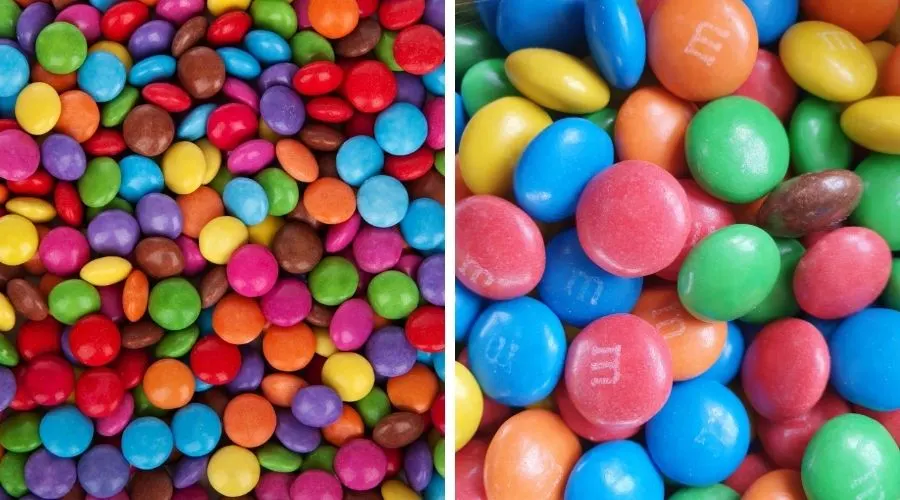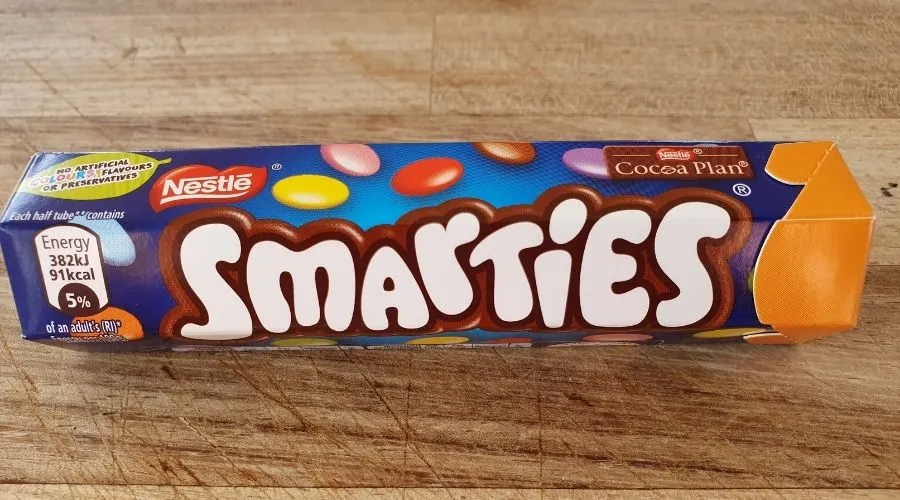Smarties and the chocolate version of M&M’s look pretty similar, and you can be forgiven for thinking they’re almost the same with their colorful crispy sugar shells and chocolate centers. Still, there are some subtle differences that separate one from the other.
In this article, I’ll be comparing Smarties head-to-head against Chocolate M&M’s to show the actual difference between the two. Including brand, chocolate, ingredient, and nutritional comparisons.
Also, we’re taking a poll to find out which is the public favorite between the two products when it comes to flavor.
Also in This Article
In a hurry, or looking for something specific? Use the links below to jump to the relevant section:

Which Came First Smarties or M&M’s?
Plain chocolate M&M’s were first introduced in the USA in 1941, which means they’ve been around for over 80 years; however, Smarties are even older and were first introduced in the UK by Rowntrees in 1882, making them over 140 years old.
When they were first released, Smarties were known as Chocolate Beans until 1938, when they were rebranded as Smarties. Nestlé now produces smarties since they took over Rowntrees in 1988.
M&M’s have remained a Mars product since they were originally introduced in 1941.
Ingredients Comparision
As you can see from the ingredients comparison table below, Smarties and M&M’s main ingredients are pretty similar, including sugar, skimmed milk powder, cocoa mass, and cocoa butter, all of which are ingredients you’d expect to find in chocolate.
The main difference between the two is that Smarties use natural flavors and colors which come from plant food and plant extracts, whereas M&M’s are produced contain artificial colors which can be identified by E numbers.
Smarties also contain orange oil to give the orange-colored sweets their unique flavor.
Manufacturer information confirms that Smarties contain 65% chocolate compared to M&Ms contain 70% and have a slightly thinner outer shell.
Please note that ingredients and chocolate percentages may vary depending on the country of manufacture.
| Smarties Ingredients | M&M’s Ingredients |
| Sugar, Skimmed Milk Powder, Cocoa Mass, Cocoa Butter, Wheat Flour, Butterfat (from Milk), Lactose and Proteins from Whey (from Milk), Rice Starch, Emulsifier (Lecithins), Colours (Beetroot Red, Carotene, Curcumin), Natural Flavouring, Spirulina Concentrate, Glazing Agents (Carnauba Wax, Beeswax White), Fruit and Vegetable Concentrates (Safflower, Radish), Barley Malt Extract | Sugar, Cocoa Mass, Skimmed Milk Powder, Cocoa Butter, Lactose, Starch, Milk Fat, Palm Fat, Glucose Syrup, Shea Fat, Stabiliser (Gum Arabic), Dextrin, Colours (E100, Carmine, E133, E160a, E160e, E170), Emulsifier (Soya Lecithin), Glazing Agent (Carnauba Wax), Salt, Flavourings, Palm Kernel Oil, Milk Chocolate contains Milk Solids 14% minimum, Milk Chocolate contains Vegetable Fats in addition to Cocoa Butter. |
Smarties Vs. M&M’s Nutritional Comparison
Moving on to the nutritional comparison between Smarties and M&Ms and to ensure the comparison is fair and accurate, this will be made weight-for-weight (per 100g).
A recommended serving of Smarties is half a 38g tube (around 16 smarties or 19g), whereas a serving of M&Ms weighs more depending on the pack size.
To ensure the comparison is consistent, I’ll be comparing Smarties against Milk Chocolate M&Ms (although other kinds are available).
Calorie Comparison
Weight-for-weight, Smarties, and M&M’s are similar in calories, and the reason M&M’s look like they contain a lot more calories per serving is because a serving of Smarties weighs less.
Per 100g, Chocolate M&M’s contain ten more calories than Smarties, although both kinds of chocolate would be considered high-calorie snacks.
| Sweet/Candy Type | Calories Per 100g | Calories Per Serving |
| Smarties | 470kcal | 89kcal |
| Chocolate M&M’s | 480kcal | 200kcal |
Nutritional Comparison
Although neither Smarties nor Chocolate M&M’s can be considered a healthy snack when comparing the two, Smarties are slightly lower in sugar and saturated fat than M&M’s; however, the difference is nominal.
The table below compares the main nutritional categories of Smarties and M&M’s per 100g of each product:
| Nutrition Type | Smarties (Amount per 100g) | Chocolate M&Ms (Amount per 100g) |
| Carbohydrates | 68g | 71g |
| of Which are Sugars | 62.8g | 66g |
| Dietary Fiber | 1.8g | – |
| Fat | 18.8g | 19g |
| of Which is Saturated Fat | 11.4g | 12g |
| Protein | 6.3g | 5.1g |
| Sodium/Salt | 0.12g | 0.13g |

Best for Flavor/Texture
We need your help to find out which the public favorite when it comes to taste between Smarties and M&M’s to gather unbiased data over time.
Please tell us which you like best between the two, and once you vote, the winner so far will be revealed (no personal information is required to vote).
What’s the Difference Between Smarties and M&M’s?
So, based on the data and information in this article, here’s a summary of everything that makes Smarties different from M&M’s, including product and nutritional differences:
- Smarties were first introduced 60 years before M&M’s, and until 1938 they were known as chocolate beans.
- Smarties have a thicker sugar shell than Chocolate M&M’s.
- Chocolate M&M’s contain a higher chocolate content and are 70% chocolate, whereas Smarties contain 65% (can vary between countries of production).
- Smarties contain natural colors and flavors whereas the colors in M&M’s are artificial.
- All Chocolate M&M Colors taste the same, whereas orange Smarties have added orange oil, making them stand out in flavor from the other colors.
- Each M&M has a signature ‘M’ on the outer shell.
- Smarties are slightly lower in calories, sugar, and fat than M&M’s, although the difference is slight.
Related Articles
I hope this article has helped you to find the information you were looking for; you might also find the following articles helpful too:
M&M’s Vs. Skittles (Which is the Best?)
Pringles Vs. Doritos (Which is the Best?)
Canned Asparagus Vs. Fresh (Which is Best)
References Used for this Article
To ensure the nutritional information used in this article is accurate, I have used data from the manufacturers; the links below contain the source information:
